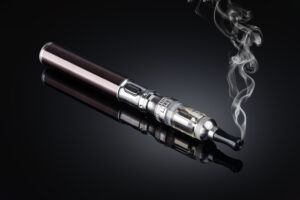
 Vapes, also called electronic cigarettes, e-cigarettes, and vaping devices, are battery-operated devices that heat a solution (e-liquid) to create an aerosol that the user inhales. The e-liquid typically contains nicotine, flavorings, and other chemicals, usually dissolved into propylene glycol and/or glycerin. While vapes do not burn or use tobacco leaves, vapes are considered tobacco products because most of them contain nicotine, which comes from tobacco. Vapes can look like traditional tobacco cigarettes, cigars, or pipes, but often resemble everyday objects like USB drives, pens, and markers.
Vapes, also called electronic cigarettes, e-cigarettes, and vaping devices, are battery-operated devices that heat a solution (e-liquid) to create an aerosol that the user inhales. The e-liquid typically contains nicotine, flavorings, and other chemicals, usually dissolved into propylene glycol and/or glycerin. While vapes do not burn or use tobacco leaves, vapes are considered tobacco products because most of them contain nicotine, which comes from tobacco. Vapes can look like traditional tobacco cigarettes, cigars, or pipes, but often resemble everyday objects like USB drives, pens, and markers.
Although many companies and advocates continue to bill them as a safer, smokeless alternative to traditional cigarettes, there is limited evidence to support this claim and the long-term effects of vape use remain unknown. We know that vapes are not harmless: nicotine in any form is highly addictive and the aerosol inhaled while vaping contains known carcinogens and toxic chemicals, as well as potentially toxic metal nanoparticles from the device itself.
Key Facts About Vaping
- Most vapes contain nicotine—the addictive drug in regular cigarettes, cigars, and other tobacco products
- Some vape liquids marketed as nicotine-free have been found to contain nicotine
- The aerosol that users inhale and exhale from e-cigarettes can expose both themselves and bystanders to harmful substances
- E-liquids contain 60 chemical compounds and E-cigarette aerosol contains 47 compounds.
- A single pod for a vaping device can contain more nicotine than 20 cigarettes.
- Selling e-cigarettes to anyone under the age of 21 is illegal in the United States
- No vaping product is FDA approved for safe use

